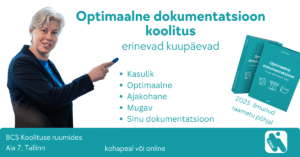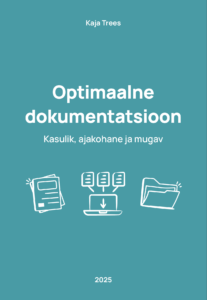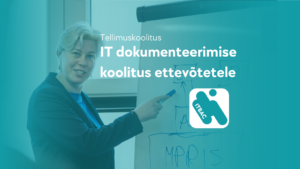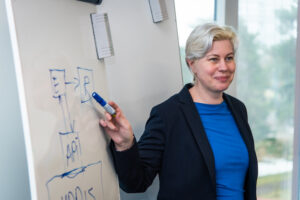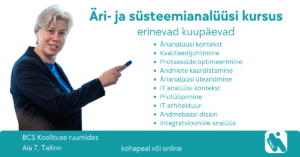useful, up to date and convenient
Author: Kaja Trees, published 2025
Optimal documentation is not about doing more — it’s about doing it smarter. Optimize your IT documentation without overcomplicating it!
This book is for IT analysts, product managers, and project leads who want to create documentation that is clear, practical, and genuinely useful.
Buy now!
- Kindle e-book (epub)
- paperback
Sold exclusively in Amazon.
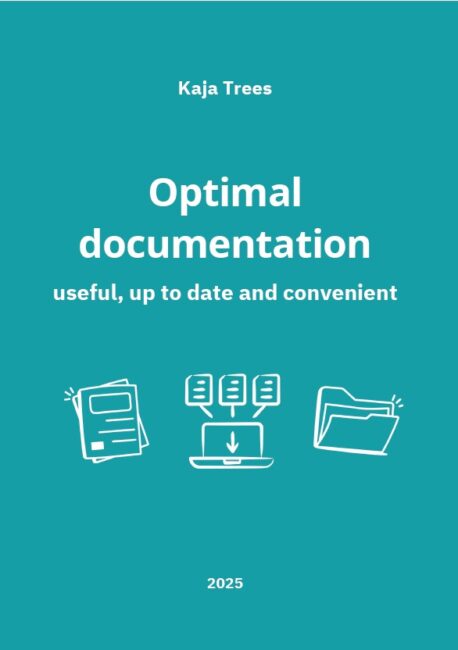
About the author
Kaja Trees is a Business and IT Systems Analyst with over 20 years of experience, combining hands-on project work with theoretical insight. She is the creator of ITBAC courses on IT and Business Analysis and a sought-after consultant.
Book details:
English edition:
- paperback, 165pg, ISBN 978-9916-4-3145-0, published August 2025
- e-book ISBN 978-9916-4-3147-4 (epub), published August 2025
Estonian edition:
- paperback 144pg, ISBN 978-9916-4-3141-2, published August 2025
- e-book ISBN 978-9916-4-3143-6 (epub), 978-9916-4-3142-9 (pdf), 978-9916-4-3144-3 (mobi), published July 2025
Key topics
Optimal documentation: useful, up-to-date, and convenient is a practical handbook for anyone responsible for creating or managing documentation.
The book is structured into five parts, guiding you step-by-step through making documentation genuinely useful and sustainable in real projects.
1. Useful
You’ll explore why documentation often feels like a burden and how to turn it into a valuable tool. Topics include:
- Why people resist documenting and how to counter common myths
- How documentation benefits you
- Organizational value of proper documentation
2. Optimal
This section helps you decide what, how and how much is enough by exploring:
- Different documentation content types
- How to make documentation understandable and usable
- Defining what “sufficient documentation” means in your context
3. Up to Date
Learn to avoid outdated specs and wasted effort by:
- Understanding why documentation gets out of date in the first place
- Understanding AS-IS, TO-BE, and workflow documentation and how to manage it
- Aligning the documentation process with your agile work processes
4. Convenient
Practical tips for making documentation easy to create, read, and maintain, including:
- Organizing shared documentation repositories
- Structuring AS-IS, TO-BE, and workflow documents
- Choosing diagramming and documentation tools
- Using AI in documentation workflows
5. Your documentation
The final part helps you bring everything together:
- How to start documenting if there’s nothing in place
- Integrating documentation into your daily work
- Creating a team-specific documentation guide
Exercises & Templates
Most chapters include exercises to help you reflect and apply the ideas. You’ll also find:
- A documentation kickoff checklist
- A meeting memo template
- Example combined documentation structure
How to document IT projects?
You’ll learn how to:
- create understandable documentation that supports real decision-making
- explore problems and align solutions through shared understanding
- keep documents up to date, even in fast-changing environments
- make documentation easier to use by choosing the right structure and tools
Based on real-world experience, this book explains key principles and includes examples and exercises to help you apply them in your daily work.
Who this book is for?
- Business analysts
- Systems analysts
- Product managers
- Project managers
- Anyone responsible for documenting
What problems does it solve?
- What to document or how much is enough?
- Your team doesn’t read or trust existing documents
- Documents become outdated quickly
- Writing feels like a waste of time rather than a helpful step
- IT documentation is missing or out of date
- You don’t know if it is possible to keep documentation up to date in agile process
- Your team doesn’t think that documentation is necessary
- Your documentation is an unstructured mess
- Your documentation is difficult to understand
- You don’t know how to keep documentation up-to-date
- Optimize documentation to meet regulatory requirements
Feedback from test readers
Test readers read an early draft of Estonian-language edition.
Elmo Puidet, business and management consultant:
This book offers not just a subtle hint but real clarity: if you want your organization to succeed, you need to build a system. And building a system requires mapping key processes and creating documentation. This helps new employees, supports day-to-day understanding of the details, and makes it easier to find root causes when something needs to be explained. In this book, you’ll find clear, accessible guidance on how to create systems and documentation in a way that truly delivers value.
Kätlin Jürss, starting IT analyst:
I consider the book very useful for beginning analysts or companies that don’t yet have analysts and are considering creating such a role. It provides excellent insight into how analysts create and maintain documentation. It also offers a very good overview of various technological options.
Although I don’t have much experience in this field, I still found several parts that validated my own working methods. At the same time, I also got many new ideas on how to better manage my work processes in the future—like updating documentation after a release, for example. I underlined quite a few sections (adding notes like “very good point!”) and plan to go through the book again alongside my work and start applying the practices. There’s too much information to fully absorb all at once anyway.
The book also reassured me that it’s perfectly okay for documentation to evolve (it doesn’t have to be perfect!) and that the analyst can decide how to present things based on the situation.
Buy now!
- Kindle e-book (epub)
- paperback
Sold exclusively in Amazon.

